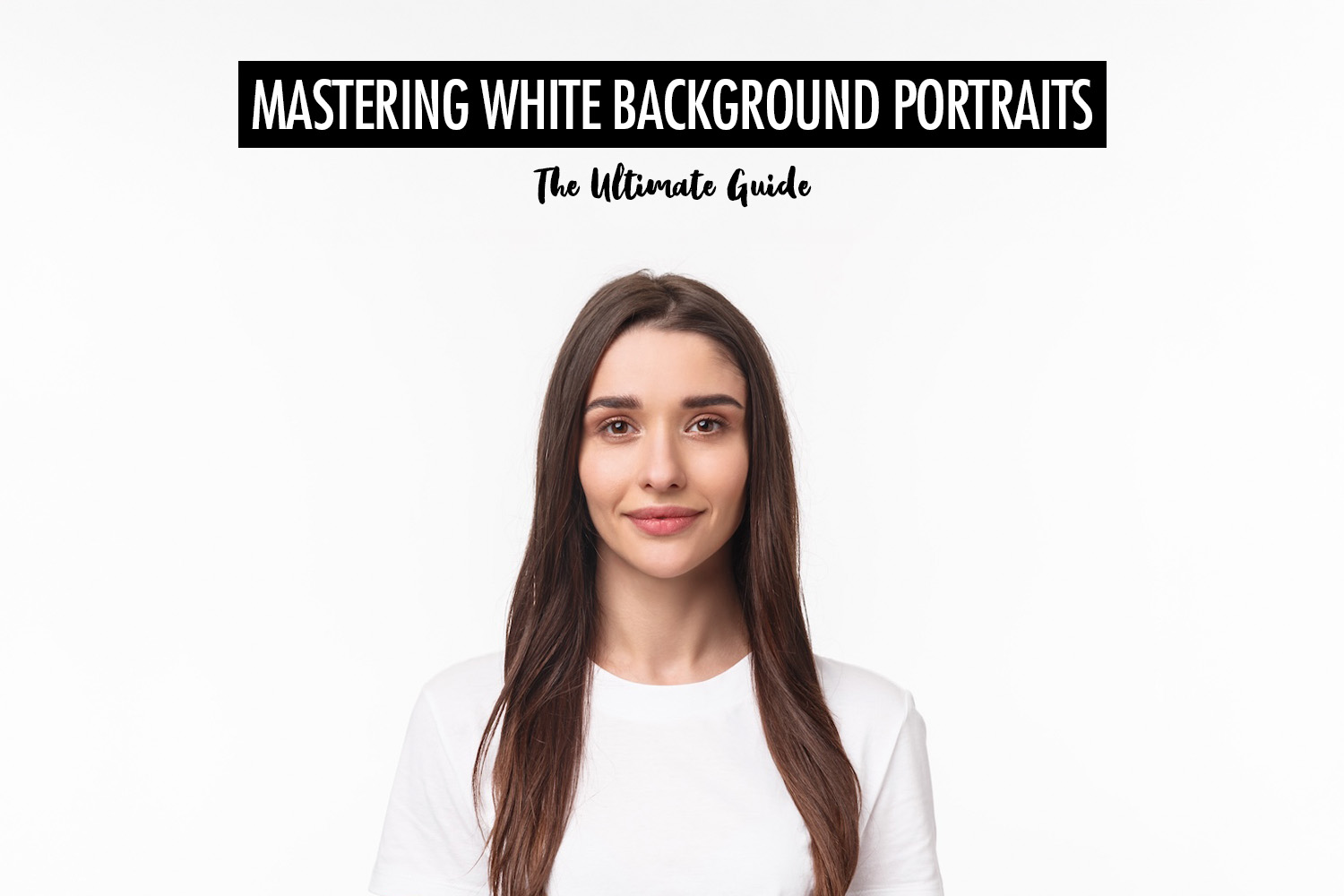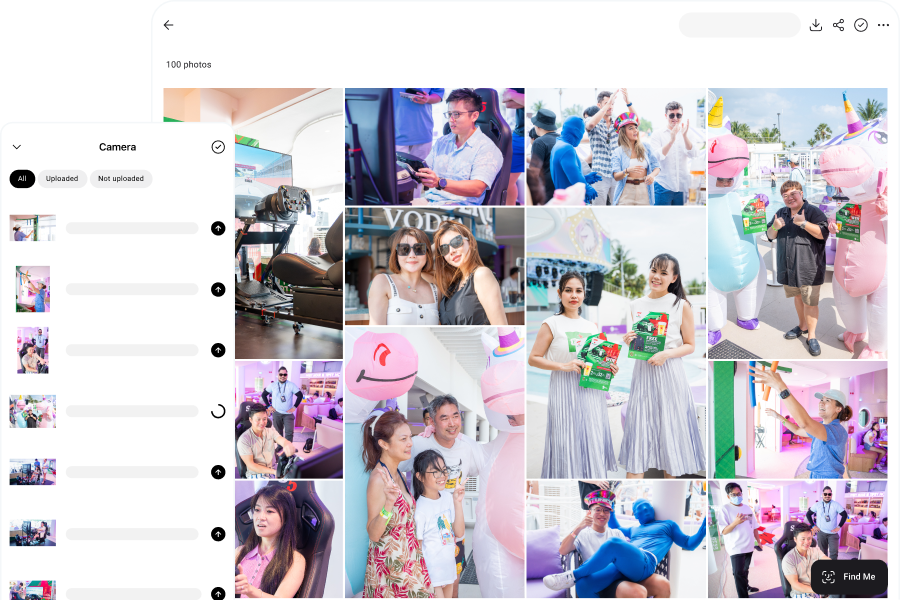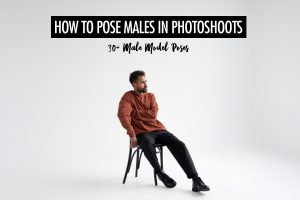White background photoshoots are a timeless favorite in portrait photography, known for their clean and professional look. The simplicity of a white backdrop ensures that the subject takes center stage, making it a popular choice for everything from corporate headshots to creative portraits. However, achieving that seamless, luminous white look requires more than just a blank wall—it’s all about precise lighting, careful setup, and attention to detail.
In this guide, we’ll cover the essential steps to perfect white background portraits, from selecting the right gear and mastering the lighting arrangement to fine-tuning camera settings. We’ll also explore how AI-powered apps and software can help you achieve stunning results more efficiently.
Whether you’re working in a professional studio or setting up a simple home studio, these insights will help you create bright, captivating portraits that truly stand out. Let’s dive in and unlock the secrets to mastering white background photography!
Why Are White Background Portraits Popular?
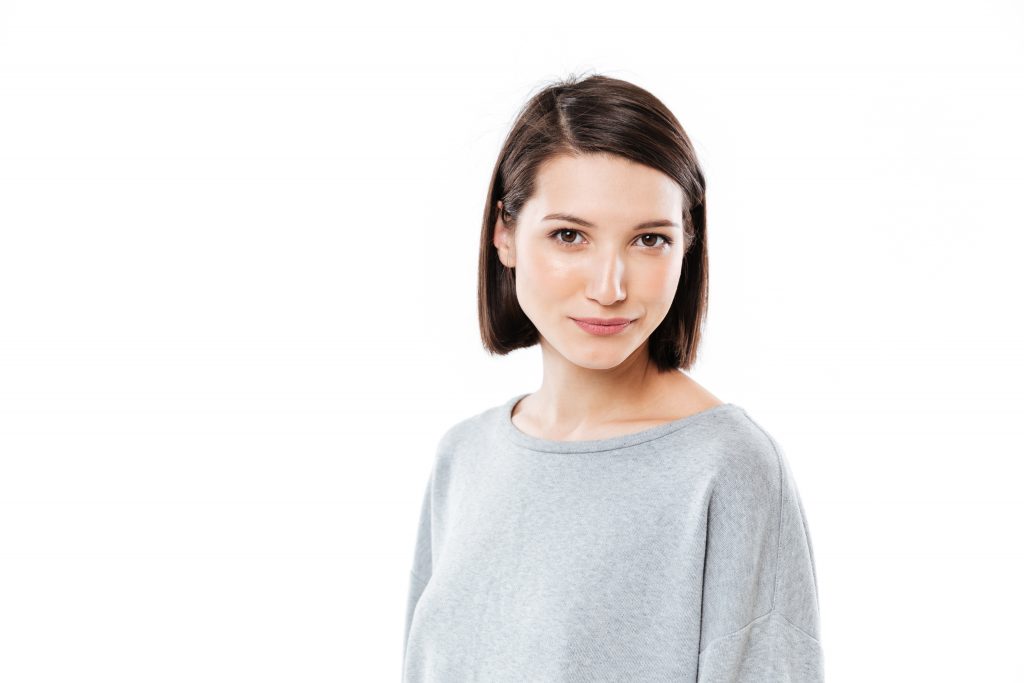
White background portraits are a go-to choice for many photographers because they provide a blank canvas that puts the spotlight squarely on the subject. The neutral tone of a white backdrop ensures that there are no distractions. Whether you’re capturing a corporate headshot, a fashion portrait, or even product photography, the result is always clean and professional. This versatility makes white backgrounds especially popular for editorial work, online stores, and social media where a crisp, uncluttered look is key.
Another reason white backgrounds are favored is their adaptability in post-production. A seamless white photography backdrop makes it easier to edit, retouch, and even remove or replace the background if needed. With the help of modern editing tools and AI-powered apps, fine-tuning exposure, color balance, and background details has never been easier. This saves time and ensures you can deliver consistently polished images to your clients.
White background photoshoots offer a timeless and universally appealing style. Unlike colored or textured backgrounds, white never goes out of style—it’s a staple that can work across a variety of projects and is always in demand. For photographers looking to build a versatile portfolio and attract a wider range of clients, mastering the white background is a must.
Finally, white backgrounds have also become a critical part of online marketing and branding. For businesses and personal brands, a white backdrop ensures consistency and uniformity across platforms, making it easier to maintain a cohesive visual identity. Plus, the minimalist aesthetic of a white background directs the viewer’s attention to the subject, helping to convey professionalism and clarity.
Whether you’re shooting a profile picture, a product image, or a creative portrait, white backgrounds deliver a versatile and polished result that meets the needs of modern visual storytelling.
Setting Up Your White Background
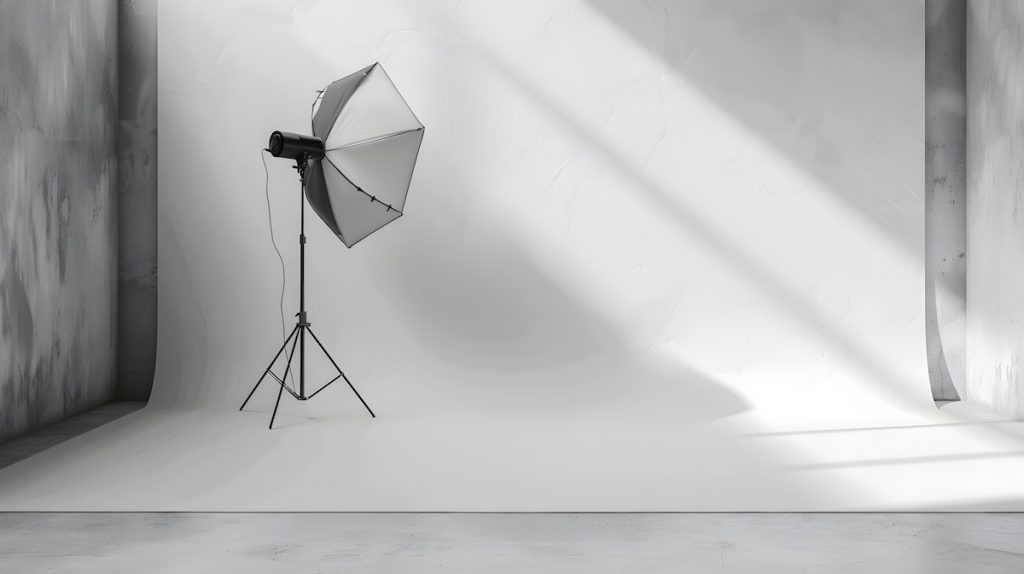
Before you dive into shooting, it’s important to get your setup just right. White background photography may look simple, but every detail—backdrop choice, lighting, subject placement, and camera settings—contributes to creating that bright, seamless look. Spending a bit of extra time on setup not only ensures professional results but also saves time in post-processing.
Let’s explore the key elements that will help you create stunning white background portraits, step by step.
Choose the Right Backdrop
The first step in creating a flawless white background is choosing the right material for your backdrop. Seamless white paper rolls are a popular choice because they provide a smooth, unbroken surface that creates a professional studio look. These paper backdrops can be easily pulled down to cover the floor, eliminating any lines or shadows where the wall and floor meet. If you’re working in a studio or have the space for it, a paper roll is an excellent investment.
Alternatively, white cloth backdrops are a versatile and portable option, especially for photographers who shoot in various locations. They’re lightweight and easy to transport, but they do require careful handling to avoid wrinkles and folds that can be distracting in the final image. If you choose to work with cloth, be sure to steam or iron it beforehand to create a crisp, clean appearance. Both options can help you achieve that seamless white background, so choose the one that best fits your working style and shooting environment.
Master Your Lighting Setup
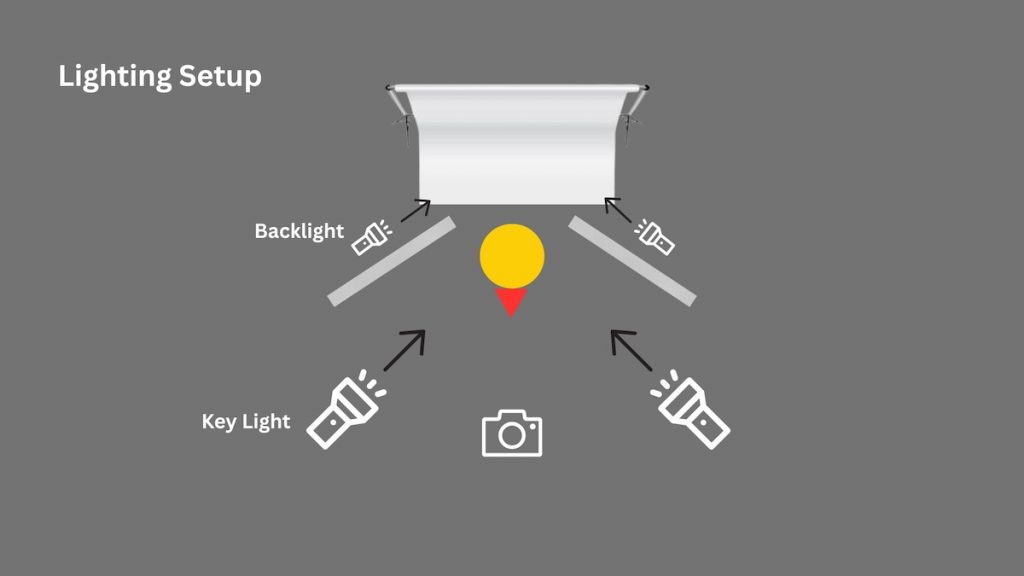
Lighting is the key to making your white photography backdrop appear truly white rather than gray. Start with a main light—often a softbox or umbrella—positioned at a 45-degree angle to your subject. This key light should be bright enough to provide even illumination across the subject’s face while still creating soft, natural shadows that add depth and dimension.
To balance the light and reduce any harsh shadows, add a fill light or reflector on the opposite side of your main light. This helps maintain even exposure and brings out details in the subject’s face.
Most importantly, dedicated background lights are essential. These lights should be placed behind or to the sides of the subject, aimed directly at the white backdrop. This prevents shadows from falling onto the background and ensures it’s bright enough to register as pure white in your camera.
One helpful technique is to use light modifiers like diffusers, grids, or barn doors to further control how your light hits both the subject and the background. Diffusers—such as softboxes or umbrellas—soften the light, creating a more flattering effect on the subject’s skin and reducing the chance of harsh hotspots. Grids and barn doors, on the other hand, allow you to direct and control the spread of your light, preventing it from spilling onto areas you want to keep in shadow. Incorporating these light modifiers not only gives you more control over your final image but also elevates the professional quality of your portraits.
There is one common pitfall you’ll want to be aware of when shooting white background portraits—overexposing the background to the point where the light spills over and creates a hazy effect that envelops your subject. Striking the right balance means getting your background bright enough for a clean white look without letting it bleed into your subject. This can be done by adjusting the position and output of the background light, and moving the subject further away from the backdrop.
Position Your Subject for Best Results
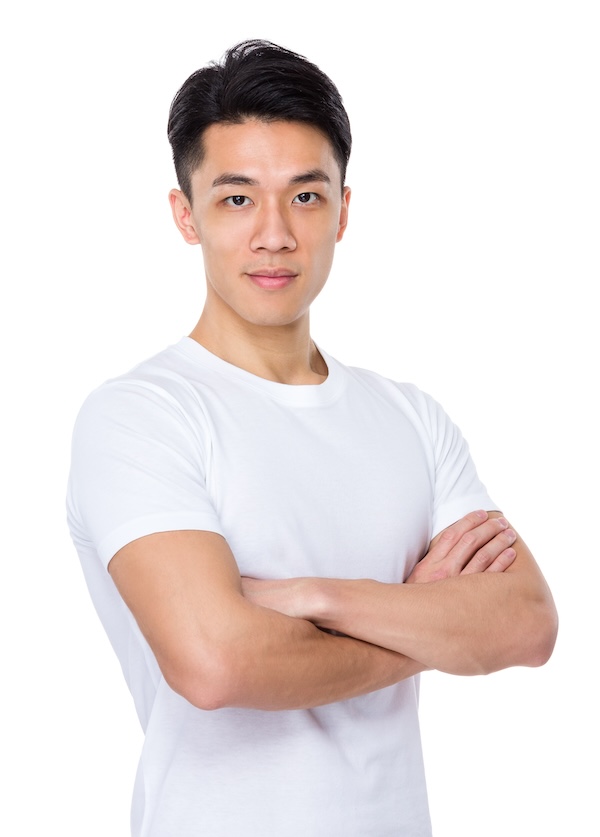
Even with the perfect backdrop and lighting, subject placement can make or break your white background portraits. Position your subject at least three to five feet away from the backdrop to minimize the risk of light bouncing off the background and spilling back onto your subject. This distance also helps reduce any subtle shadows that might otherwise draw attention away from your main subject.
Another important consideration is the subject’s height and posture relative to the camera angle. Adjust your camera height and lens choice to flatter the subject’s features and avoid distortion, especially in close-up portraits. For example, shooting slightly above eye level tends to be more flattering for most people, creating a natural and engaging look. Proper posture and relaxed expressions also play a big role in making your subject appear comfortable and confident, which ultimately enhances the overall quality of your white background portraits.
Use Longer Lens to Avoid Distortion
When shooting portraits against a white background, it’s important to consider how lens choice can affect the final image. A longer lens, typically in the range of 85mm to 135mm for full-frame cameras, helps avoid the distortion that can occur with wider lenses. Wide-angle lenses tend to exaggerate facial features, making noses appear larger and faces look slightly stretched—something that can be unflattering, especially in close-up portraits.
By switching to a longer lens, you can maintain a more natural, proportionate look for your subject. This not only results in more flattering portraits but also works well with the clean, distraction-free vibe of a white background, ensuring your images have that classic, timeless appeal.
Get Your Camera Settings Right

Finally, getting the shot right in-camera helps to simplify post-processing. Start by setting a low ISO—usually 200 to 800—to minimize noise and maintain a clean image. Use an aperture around f/5 to f/8 for optimal sharpness across the portrait, ensuring your subject remains crisp and in focus.
Shutter speed is also crucial; aim for around 1/125 to 1/200 of a second to sync with your lighting setup and avoid motion blur. White balance is another important factor. If you’re using studio strobes or LED lights, set your white balance to daylight or manually adjust it to match the color temperature of your lights. This helps keep your whites looking bright and consistent without color casts.
In addition to these basic settings, shooting in RAW format is highly recommended for white background photoshoots. RAW files capture more image data than JPEGs, giving you greater flexibility in post-processing. This allows you to fine-tune exposure, contrast, and color balance without degrading image quality. Using RAW also makes it easier to correct any slight imperfections in the white background or subject lighting, ensuring a clean and professional final result.
Wrapping up
Setting up a white background photoshoot may seem straightforward, but getting every element right is crucial for achieving professional results. Choosing the right backdrop sets the foundation, whether it’s seamless paper or a wrinkle-free muslin cloth. Mastering your lighting setup with key, fill, and background lights ensures your white backdrop stays bright and shadow-free, while light modifiers give you precise control over your scene. Proper subject placement—keeping them a few feet away from the background—prevents unwanted light from bouncing back onto your subject and reduces shadows falling on your backdrop. Finally, dialing in your camera settings—from ISO and aperture to white balance and shooting in RAW—helps capture sharp, clean images that make post-processing easier.
By paying close attention to each of these steps, you’ll be able to consistently produce stunning portraits with a seamless white background, whether you’re shooting in a studio or on location. This solid foundation will give you the confidence and creative freedom to experiment with poses, expressions, and lighting styles while maintaining that classic, clean aesthetic.
Essential Gear Checklist

When it comes to white background photography, having the right gear is just as important as mastering your technique. The following checklist covers the essential equipment you need to ensure your photoshoot runs smoothly and delivers high-quality results. Each piece of gear plays a vital role in controlling light, creating a seamless white backdrop, and capturing sharp images.
White Backdrop
A high-quality white photography backdrop is the foundation of your photoshoot. Whether you choose a seamless paper roll or a muslin cloth, it provides the clean canvas necessary to make your subject pop. Seamless paper backdrops are ideal for studio work due to their smooth surface and ability to cover both the wall and floor without visible creases. Muslin cloth offers flexibility for on-location shoots but requires extra care to keep wrinkle-free.
Since a white backdrop is such a crucial element in achieving clean, professional portraits, we’ve created a separate section below to help you explore the different kinds of backdrops you can choose from and how they fit your specific shooting needs. Investing in a durable backdrop ensures your photos will have a consistent, professional look.
Studio Lighting Kit
Lighting is the most crucial gear for white background photography. A studio lighting kit typically includes at least two strobes or continuous lights, along with modifiers like softboxes or umbrellas. These lights allow you to evenly illuminate both your subject and the backdrop, preventing unwanted shadows and achieving that pure white effect. Without proper lighting, the backdrop can appear gray or uneven, undermining the clean aesthetic you’re aiming for. A reliable lighting setup also gives you creative control over the mood of your portraits.
Light Modifiers
Light modifiers such as softboxes, umbrellas, grids, and barn doors help you shape and control your light sources. Softboxes and umbrellas diffuse light, creating soft, flattering illumination on your subject’s face. Grids and barn doors focus and restrict light spill, preventing background lights from affecting your subject. These tools are essential for fine-tuning your lighting and achieving a polished look without harsh shadows or hotspots.
Sturdy Light Stands and Backdrop Support
To keep your lighting and backdrop stable, invest in strong, adjustable light stands and a reliable backdrop support system. Wobbly or unstable stands can cause lights to shift or backdrops to sag during your shoot, leading to inconsistent lighting and distracting wrinkles. A solid support system ensures your setup stays consistent throughout the session, helping you maintain focus on capturing great shots.
Quality Camera and Lens
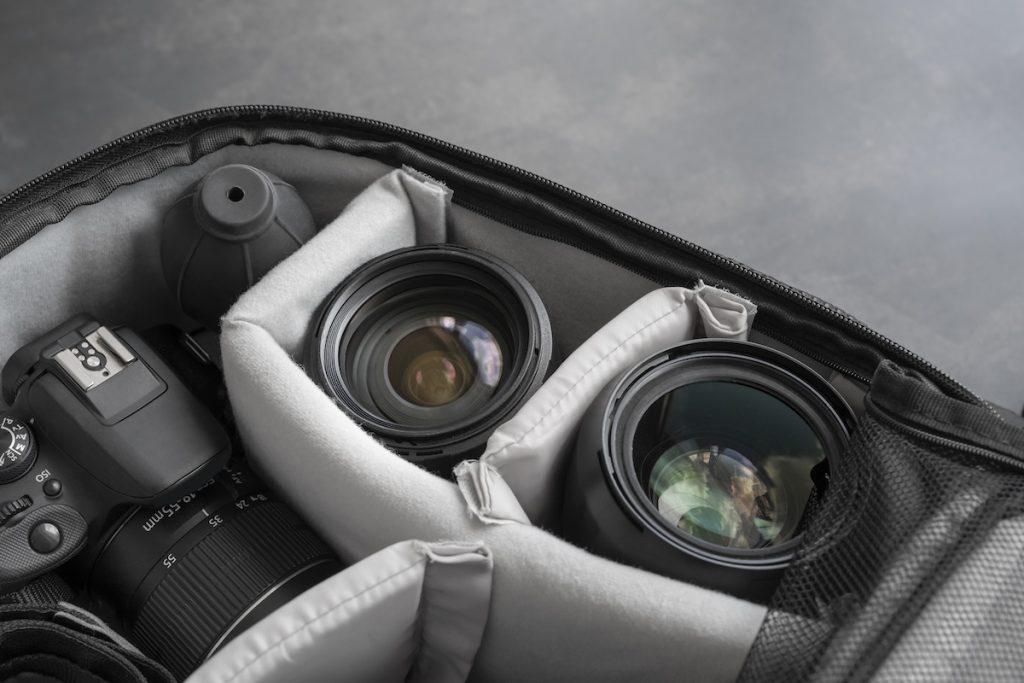
Your camera and lens directly affect the sharpness and detail of your portraits. Get a DSLR or mirrorless camera with manual controls, allowing you to precisely adjust settings like aperture, shutter speed, and ISO. For lenses, a focal length between 50mm and 85mm is often preferred for portraits because it produces a flattering perspective and sharp images with pleasing background blur. Investing in quality gear helps you capture professional-level images that showcase your subject beautifully against the white backdrop.
Reflectors and Diffusers
Reflectors bounce light back onto your subject to fill in shadows and create even skin tones, while diffusers soften harsh light before it hits the subject or backdrop. These inexpensive but effective tools help balance your lighting setup and reduce the need for additional light sources. Using reflectors and diffusers can enhance the overall lighting quality, making your portraits appear more natural and well-lit.
Remote Shutter Release and Tripod
A remote shutter release combined with a sturdy tripod helps you take multiple shots with consistent composition. Using a tripod and remote also frees you up to interact with your subject and adjust lighting.
Having these essential gear in your toolkit will set you up for success and streamline your white background photoshoot from start to finish. Each piece plays a specific role in creating the clean, bright, and professional portraits you’re aiming for.
Affordable White Photography Backdrops
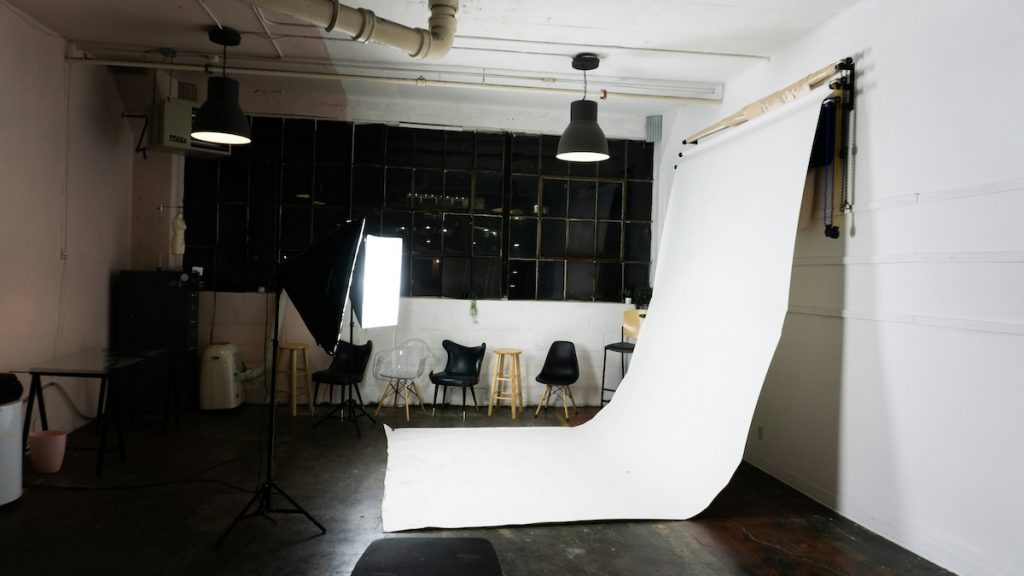
Creating stunning white background portraits doesn’t have to mean investing in expensive studio gear. With a bit of resourcefulness and the right materials, you can achieve that clean, professional white background look on a budget. Here are some cost-effective options to consider.
DIY Seamless Paper
If seamless paper rolls are out of your budget, consider using white craft paper or large sheets of poster board as an alternative. These materials are widely available at most craft stores and are inexpensive compared to dedicated white photography backdrops. They offer a smooth, uniform surface that mimics the clean, professional look of seamless paper. While they’re generally best suited for smaller-scale shoots—like product photography or tight headshots—they can still deliver excellent results with the right lighting.
Since these materials can be easily cut or taped together, they’re also great for experimenting with different shooting angles and framing, making them a flexible option for photographers working with limited resources.
Cloth
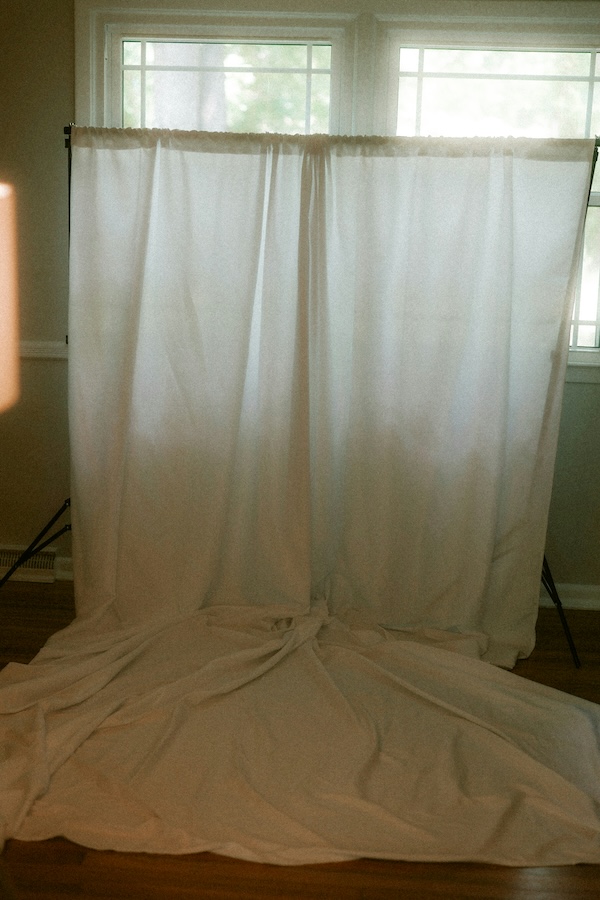
A clean white bedsheet, muslin cloth or even a tablecloth can be surprisingly effective as a backdrop, especially if you’re shooting in a home studio or a makeshift location. Look for cotton or polyester blends that hang smoothly and don’t show much texture or weave detail. Be sure to thoroughly iron or steam the fabric before shooting to eliminate wrinkles, as even slight folds can cast unwanted shadows in your final images.
Once smooth, secure the backdrop tightly using clamps, tape, or a backdrop stand to maintain a flawless surface throughout the shoot. While not as robust as professional backdrops, bedsheets and tablecloths offer a budget-friendly and flexible option that can still create that crisp white background look when properly lit and styled.
Foam Board or Cardboard
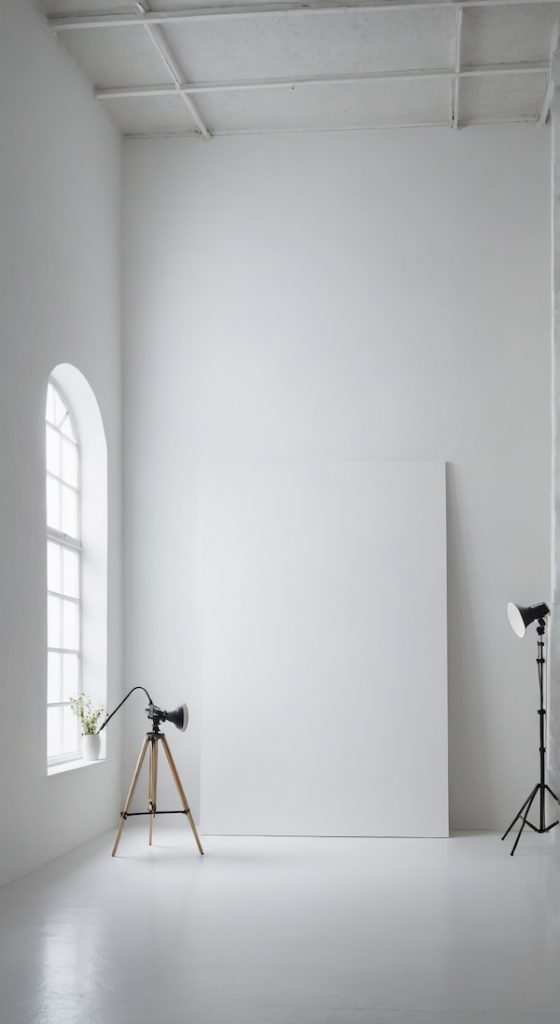
Foam boards and large white cardboard sheets are excellent options for those who need a simple and portable backdrop. Lightweight and easy to maneuver, these materials work particularly well for close-up portraits, headshots, or product photography. One of their biggest advantages is that they can also serve as light reflectors or bounce cards, brightening up shadows on your subject and enhancing the overall exposure of your shot. The smooth, matte surface of foam board minimizes glare and helps maintain a clean, consistent look for your background.
While foam board or cardboard may not cover large areas like seamless paper rolls, they’re an excellent choice for smaller setups and quick, professional-looking results—especially when you’re on a tight budget.
V-Flats
V-Flats are a fantastic addition to any backdrop setup, doubling as reflectors and white backgrounds. Made from large foam-core or gator board panels hinged together in a V shape, they can create a seamless, bright backdrop while also bouncing light back onto your subject for that extra pop.
While V-Flats are traditionally used in professional studios, resourceful photographers have found ways to make them work with hardware store materials like styrofoam insulation boards. These boards are lightweight, inexpensive, and easy to paint white for a clean background effect. However, they can be unwieldy to transport and store, especially in small studios or home setups.
Still, if you have the space and patience to maneuver them, V-Flats can be an affordable and flexible solution that adds both background and lighting control to your toolkit.
White Wall
Sometimes, the simplest solution is right in front of you—a clean, white wall can serve as an effective and budget-friendly backdrop. Many homes, offices, and rental studios have plain white walls that can be easily transformed into a seamless white background with the right lighting.
While a white wall might not offer the same level of flexibility as dedicated backdrops, it’s an accessible starting point for achieving that clean, minimalist aesthetic in portrait or product photography. To get the most out of this setup, ensure the wall is free of scuffs, marks, or uneven textures, as these can become distracting in your final image.
Rent a Studio With a CYC Wall
If you’re aiming for a truly seamless white background and have some flexibility in your budget, consider renting a studio space that features a cyclorama (or “cyc”) wall. A cyc wall is a curved, infinity-style wall that eliminates corners, creating a boundless white space that’s perfect for full-body shots, fashion shoots, and creative commercial photography. These specialized studios are designed to offer an ultra-clean, shadowless backdrop that elevates your photos to a professional level.
Renting a studio with a cyc wall can save you the time and hassle of setting up backdrops while giving you access to lighting, high ceilings, and ample working space. Even if you’re working on a budget, many studios offer hourly rates or discounted packages that make this option surprisingly affordable for one-off shoots or special projects.
AI Software to Enhance White Background Portraits
Post-production work is essential for cleaning up the backdrop and adding that final professional polish. With the help of AI-powered apps and software, you can perfect your white background images. Here’s a roundup of some of the most popular and effective tools that can help you achieve clean white backgrounds with minimal fuss.
Adobe Lightroom
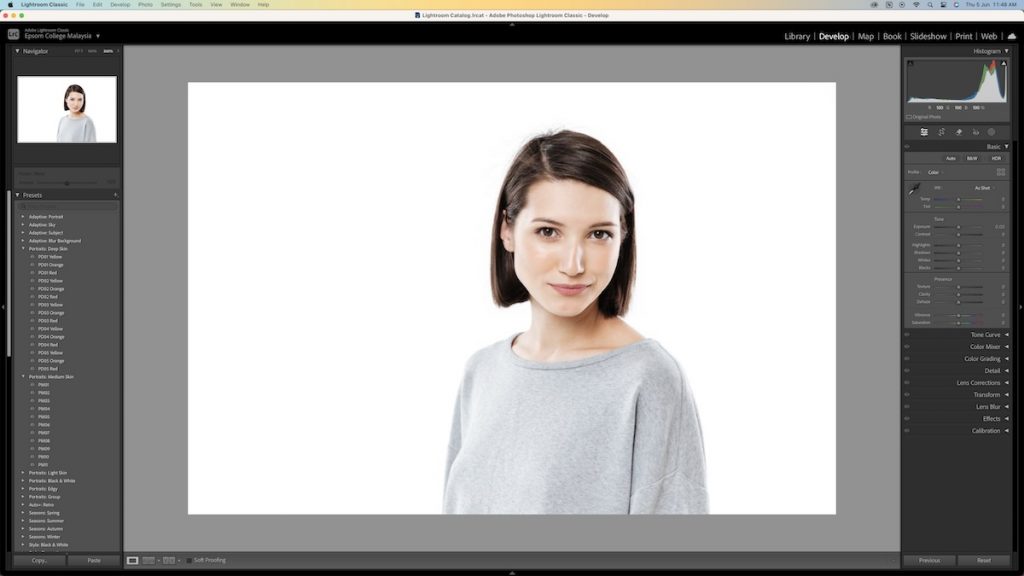
Adobe Lightroom is a go-to tool for photographers perfecting white background portraits, thanks to its exposure and white balance controls that help create a clean, uniform backdrop. Its AI-powered subject detection and selective editing tools allow you to brighten and clean up the white background without impacting your subject, ensuring a polished, distraction-free image. With batch editing, Lightroom makes it simple to achieve a seamless white background across multiple photos, turning even home studio shoots into professional-quality portraits.
Luminar Neo
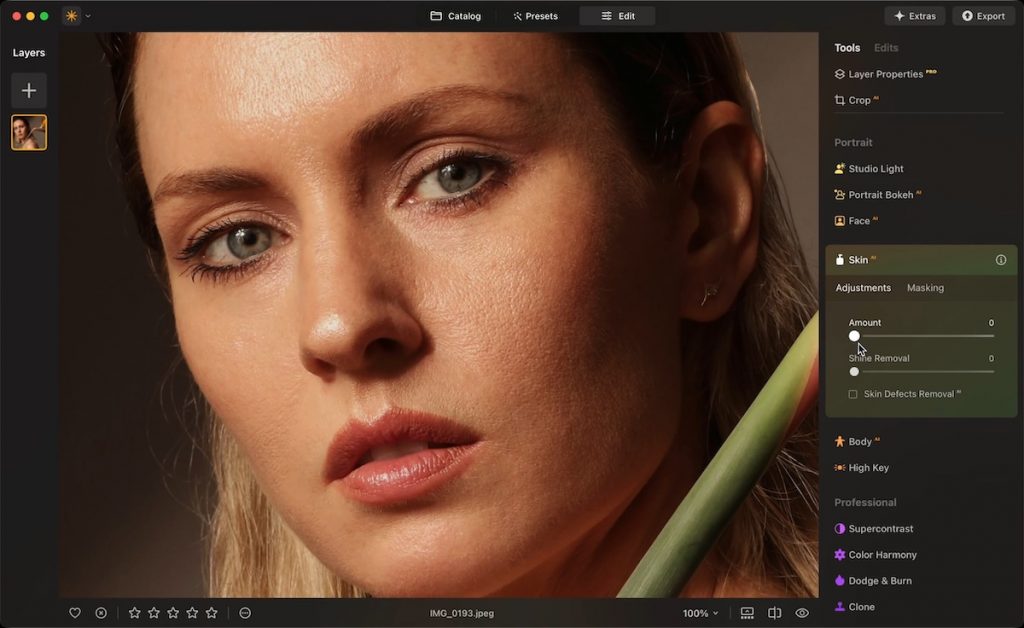
Luminar Neo is a powerful editing software that leverages AI to make retouching fast and intuitive. Its background removal tool can automatically detect and separate your subject from the background, helping to create a perfect cutout. Additionally, Luminar Neo’s AI tools can enhance skin tones, remove blemishes, and even adjust lighting to give your portraits a polished, professional look.
Topaz Photo AI
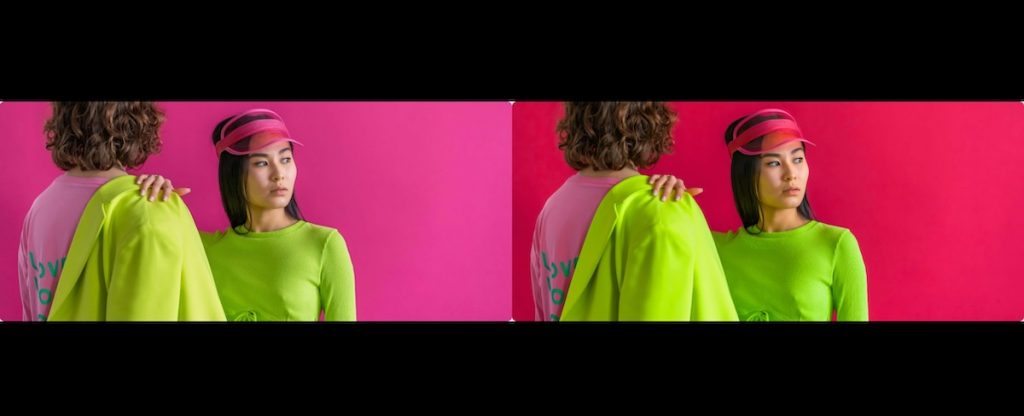
Topaz Photo AI is a standout for its AI-driven sharpening, noise reduction, and upscaling features. If your white background photoshoot images need a bit of extra sharpness or if you’re working with lower light conditions, this tool can rescue details and produce stunning, noise-free portraits.
Remove.bg

For photographers who want to quickly isolate their subject from any background, Remove.bg is a simple and effective solution. This AI-powered tool automatically removes backgrounds with high accuracy, leaving you with a transparent PNG file of your subject. You can then place the subject on a white background to create a clean portrait.
Canva
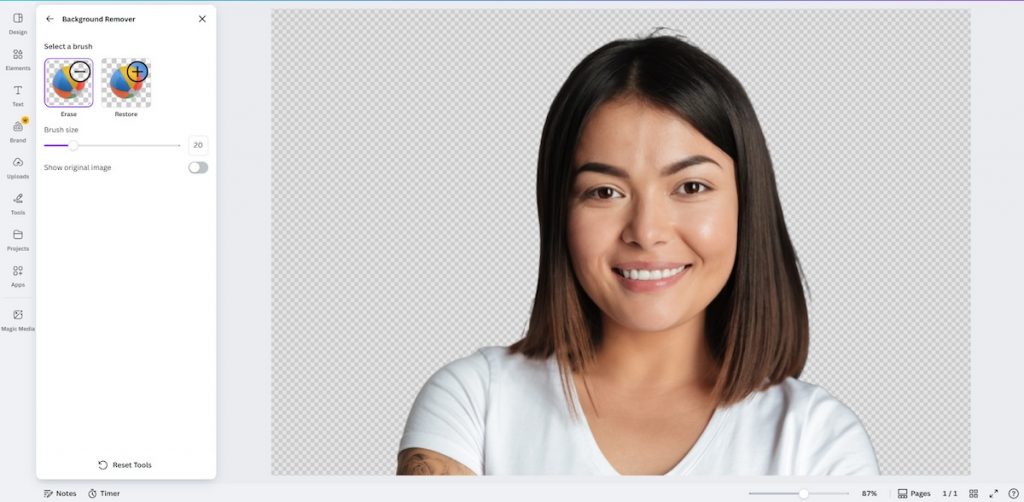
Canva is a versatile online design tool that can complement your white background photography workflow. While it’s not a dedicated photo editor, Canva offers an easy way to create clean, professional presentations or marketing materials with white background photography. Its AI-powered background remover can quickly isolate your subject and apply additional graphic design elements like text overlays, logos, and more. Canva is especially useful for photographers creating marketing assets, social media posts, or client proposals.
Evoto
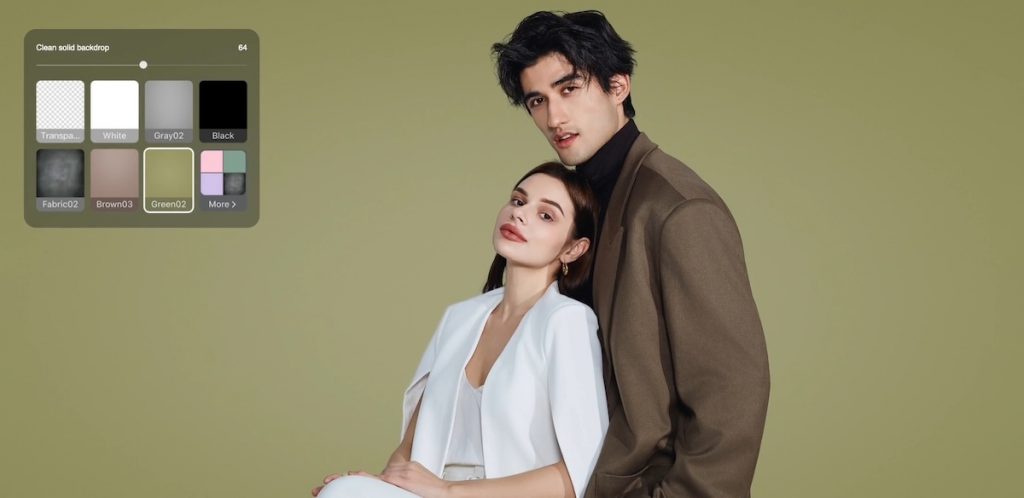
Evoto is an AI-powered retouching app that makes editing white background portraits a breeze. Its batch processing feature is a lifesaver when dealing with large sets of white background images, ensuring consistent and professional results throughout your shoot. It can also automatically detect skin tones, remove blemishes, and smooth out imperfections.
Retouch4me
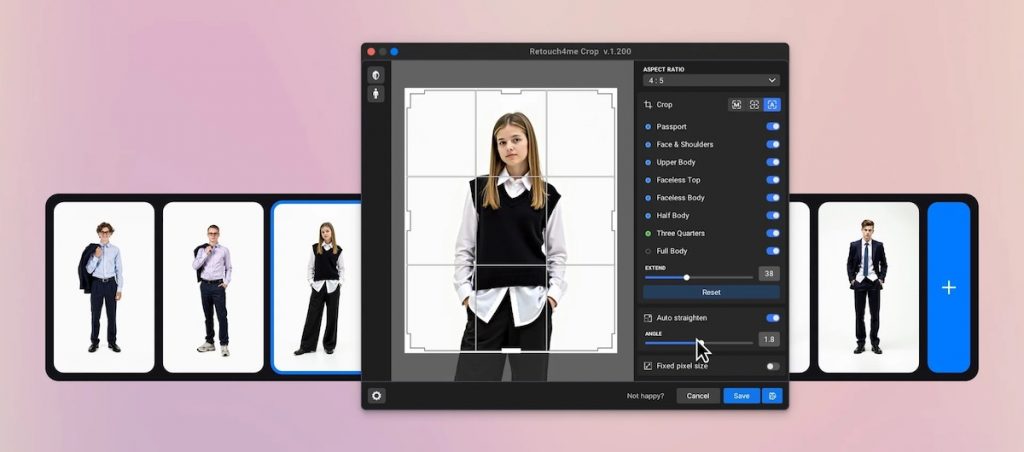
Retouch4me offers a suite of specialized AI plugins that can enhance your portraits in just a few clicks. With tools designed for skin retouching, background cleaning, and even eye enhancement, Retouch4me is perfect for refining those final details in your white background portraits. Its automatic processing saves time while delivering high-end retouching quality typically seen in professional studio work.
For an in-depth look, read our full review.
Pixlr

Pixlr is an easy-to-use online editor that’s great for quick edits on the go. It features an AI-powered background remover that can quickly clean up white photography backdrops or replace them with minimal effort. Additionally, Pixlr’s suite of creative filters and overlays can add a unique style to your final images if you want to experiment with different looks while maintaining the clean white backdrop as your base.
PhotoRoom

PhotoRoom specializes in background removal and enhancement, making it a perfect companion for white background photoshoots. With just a few taps, it can separate your subject from the backdrop and create a seamless, professional-looking cutout. PhotoRoom also offers simple editing tools to fine-tune lighting and color balance, so you can add your final touches to the white background portraits.
Picsart
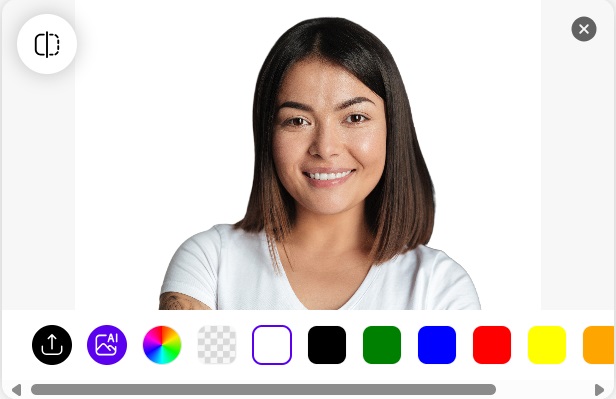
Picsart is a versatile editing app that blends creative features with powerful AI tools, making it a great choice for refining white background photography. Its AI-powered background remover is particularly handy for quickly isolating your subject and ensuring a uniform white background.
Beyond the background remover, Picsart offers a wide range of filters, retouching tools, and design elements, allowing you to add subtle enhancements or experiment with more artistic edits. Whether you’re cleaning up blemishes or simply adding a creative flair to your white background portraits, Picsart’s user-friendly interface makes it accessible for photographers at any skill level.
Instantly Share Your Portraits
There are a couple of reasons why you might want to instantly share your portraits:
- You’re shooting at a public event (such as a job fair or roadshow) with a mobile portrait studio. Since you do not have the contact details of the participants, sharing the portraits on-the-spot cuts down on the manual work of collecting the details and distributing the photos after the event.
- By sharing the portraits right away and allowing participants to choose their preferred photos to edit, you get immediate buy-in and involve them throughout the process. With a collaborative process, you increase satisfaction and reduce back-and-forth communications after the shoot.
Honcho lets you instantly share your portraits by uploading them from camera to cloud, as you shoot. The portraits are available for viewing and downloading in an online gallery, seconds after they are taken.
After uploading, you can instantly apply editing presets or have an assistant edit the photos with the built-in collaborative photo editor. This makes it possible to deliver edited portraits in just seconds.
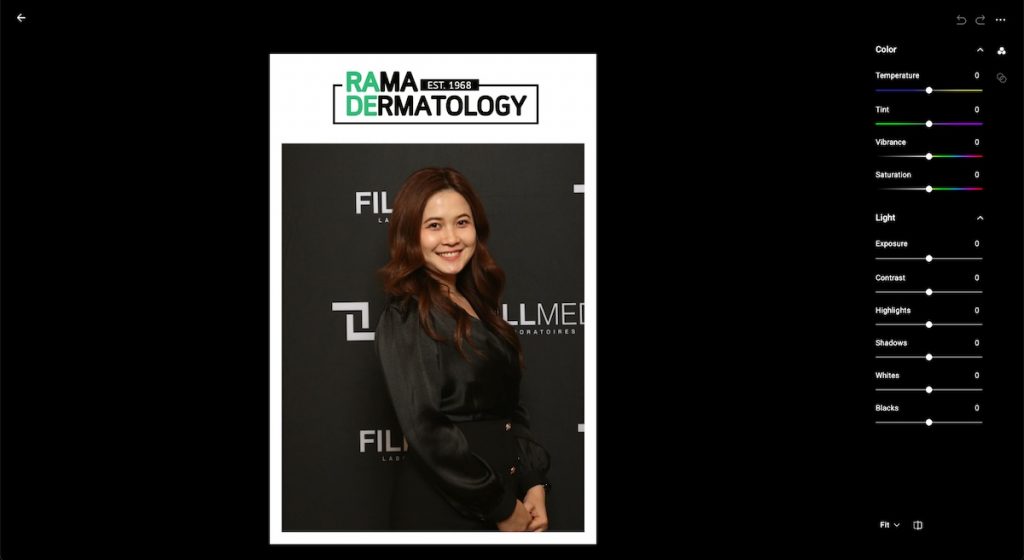
You can automate distribution by letting participants find their own photos with face recognition, just by uploading a selfie. And you can add to the overall experience with live slideshows and wireless printing.
It’s the better way to share the right photos with the right people. It saves you time by automating the manual process of distributing photos, and helps you upsell your clients with add-ons like live slideshows.
Conclusion
Achieving a perfect white background in your portraits helps you create a professional, timeless look that puts the focus on your subject. With careful planning during the shoot, the right gear, and a solid post-production workflow, you can produce striking, clean images that stand out in any portfolio or project. From choosing the right backdrop material and fine-tuning your lighting, to leveraging the power of AI apps and software like Adobe Lightroom and its alternatives, there are countless ways to elevate your white background portraits to the next level.
Don’t be afraid to experiment with different techniques and tools until you find the approach that works best for your unique style and budget. Whether you’re working from home, in a studio, or on location, these strategies will ensure your white background portraits are polished, professional, and ready to make an impact.

